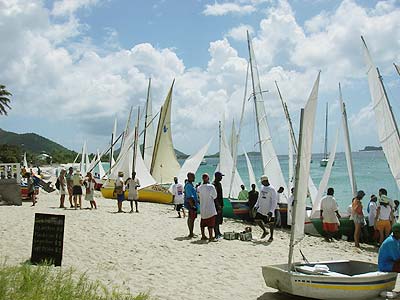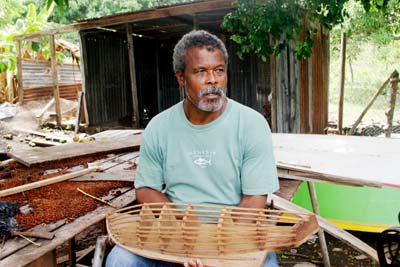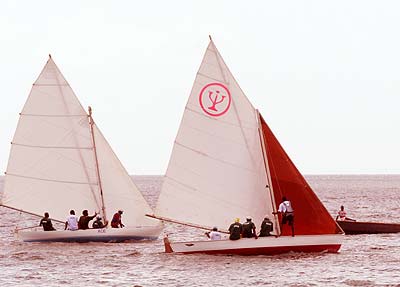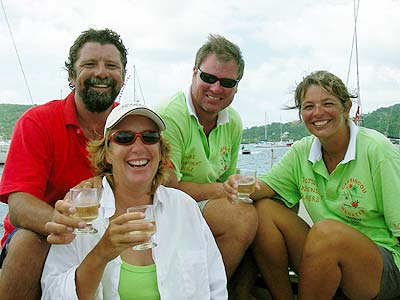The Carriacou Regatta Festival

08/10/2006, hillsborough, Carriacou
“All racers, to your boats. 5 – 4 – 3 – 2 – 1 GO!” That’s the sound of every start for the many different classes (or sizes) of Traditional Work Boats racing from the beach in Hillsborough, Carriacou. Welcome to the 41st Carriacou Regatta Festival here in the small island of Carriacou, Grenada. We’ve returned to Carriacou from St. Georges, to take part in one of the island’s largest and oldest regattas. Unlike an earlier regatta in the Bahamas where David crewed on a traditional work boat, here we were spectators from the beach with thousands. However, the parallel or concurrent regatta amongst cruisers enabled us to race on 2 other cruiser’s boats just for the fun of it.
Today, Carriacou has a boat building tradition that is alive and well, thanks in large part to the vision of John Linton Riggs, a naval architect designer and master yachtsman from Jamaica. Mr. Riggs settled in Carriacou at the age of 70, more than 40 years ago. Wooden ship building was drawing to a close when Mr. Riggs moved to the island. He wanted to boost the local boat-building and sea-faring industries. As he saw it, boat building would create assets and jobs and the boats could be used for both cargo and fishing. Mr. Riggs also knew the competitive nature of the human spirit. His regatta was aimed at the professional boat builders and skippers who could race amongst themselves and have a chance to win cash for their effort. On July 31st, 1965 entrants of the first racing yachts were attracted to this event from Grenada, Trinidad and Tobago, Antigua, Australia, Great Britain, the USA and Canada. On our previous visit to Carriacou, we met Master Boat Builder, Alwyn Enoe. He is living proof of Mr. Riggs’ dream. Last year, he built a 40-foot Carriacou sloop on the beach in the community of Windward. This year, he plans to do the same.
The Boats The traditional work boats are all gaff rigged wooden boats. As the title says, they are working boats. One boat in the regatta, Perseverance from Bequia, was used in this year’s whale hunt. On a gaff rigg, the sails are square or four pointed as opposed to a triangular shaped sail (like the modern day sloop). The gaff rigg means the mast does not have to be tall which makes it easier to hold up. The sail area tends to be much wider, so the boom is longer and in many cases it sticks out over the end of the boat. Most of the boats have removable ballast (weights) so the crew can add lead ingots if more weight is needed, particularly when the wind was stronger. You can see from the photos these boats have lots of crew relative to their size and they have large sail area compared to contemporary boats. This makes for exciting sailing.
The boats range in size and crew. The smaller racers about 3.5 m (or 12 ft) in length have 3 crew while the largest boats are about 8 m (or 28 ft) and race with 6 crew. One or two racers in each of the larger boats also wear harnesses to help them hang over the side of the boat while attached to a trapeze (a wire). These crew stand with their feet on the gunwales (the edge of the boat) and lean back. This helps to get their weight further out over the water. The boat then doesn’t heel as much and it’ll go faster.
Looking at these boats closely, what immediately jumped out was the exceptional condition of each hull. They were all smooth, shiny and faired while the rest of the boat’s equipment was a patchwork of bits and pieces. The biggest boats in the regatta were the exception – everything was new. The simplicity of the equipment was also very noticeable. We saw sails that were a composite of other sails or reshaped sails from charter boats. Sail makers here make use of whatever they can get their hands on. Sailors have to be resourceful – as equipment here is expensive. A traditional sail maker we met in Bequia, Alleck, was at the Regatta racing his boat, Limba. Alleck has the advantage of knowing how to make good sails for his boat and as a result, he does very well in the racing circuit in the Caribbean chain.
On all the boats, poles for the gaffs are made of bamboo. Bamboo is very plentiful here and because of its lightness, it’s easy to maneuver. As with all gaff rigged boats, there are no tracks for the sails along the boom. Instead, the sails are lashed to the boom with rope. On some of the boats, the battens (stiffeners) in the sails – typically made of fiberglass and are very expensive – were made of PVC plumbing pipe. It was refreshing to see the resourcefulness of everyone involved. Sailors were solving their boat issues with what they could put their hands on. Solutions were always at hand rather than heading to a specialty store. It seemed to us, it didn’t come down to who spent the most money on their boat as we tend to see in North America.
On the international racing circuits in Europe and North America, if racers believe the rules of racing have been broken by other boats, then a protest can be made. To indicate a protest, the boat will raise a red flag and then bring the problem to the race committee to adjudicate the issue. Protests are not part of this regatta. Instead, what you’ll see is crew members pushing the competitor’s boat with their hands if they are about to hit. Once boats have landed on the beach, racers will have lively discussions while eating lunch or having a refreshment. Then it’s back to racing after lunch or partying at the end of the day.

If you need to discuss a race or talk about tactics, there’s time for that on the beach after each race.
The Spectators Another early consideration for these events have been the spectators. This is new for us – racing as a spectator sport. Regattas at home are commonly off shore. A sailing regatta is considered a spectator sport in the Caribbean. We saw this in Little Farmers, Bahamas, Antigua and Cannuoan (SVG). Here in Carriacou, in 1983, the race course was changed to give spectators a better view of the races. So this was a treat to be amongst the racers and their boats on the beach, at the start. And then head up to a perch and watch the race from shore. Thousands of spectators sat on the beach, along the town pier, on restaurant balconies or bobbed along on big party boats watching the races.
The future
Oppies were the other impressive class at the Carriacou regatta. All week in Tyrell Bay, we watched children from about 6 – 12 years old, sailing in these 2m fibreglass sailboats around the big cruising boats. On the morning of the regatta, we watched one of the organizers with 8 Oppie’s trailing behind each other, tow the boats over to Hillsborough – 2 nm away. It looked like mother duck with her little ducklings behind. (Don’t worry, the boats were empty). The children had their own start and race following the last of the traditional boats. It’s terrific to see that not only here but throughout the Caribbean where you see these simple, single gaff sail boats, the sport of racing is incredibly active. Kids are as eager as ever to take to the water. To include them in this regatta where they watch the masters is securing the future of this sport and this Regatta. Congratulations on a terrific event Carriacou Regatta organizers. Mr. Riggs would be proud to see what you’ve done with this event.

The youngest racers at the Regatta sailed Optimists. They started their race just after the biggest boats got started.




